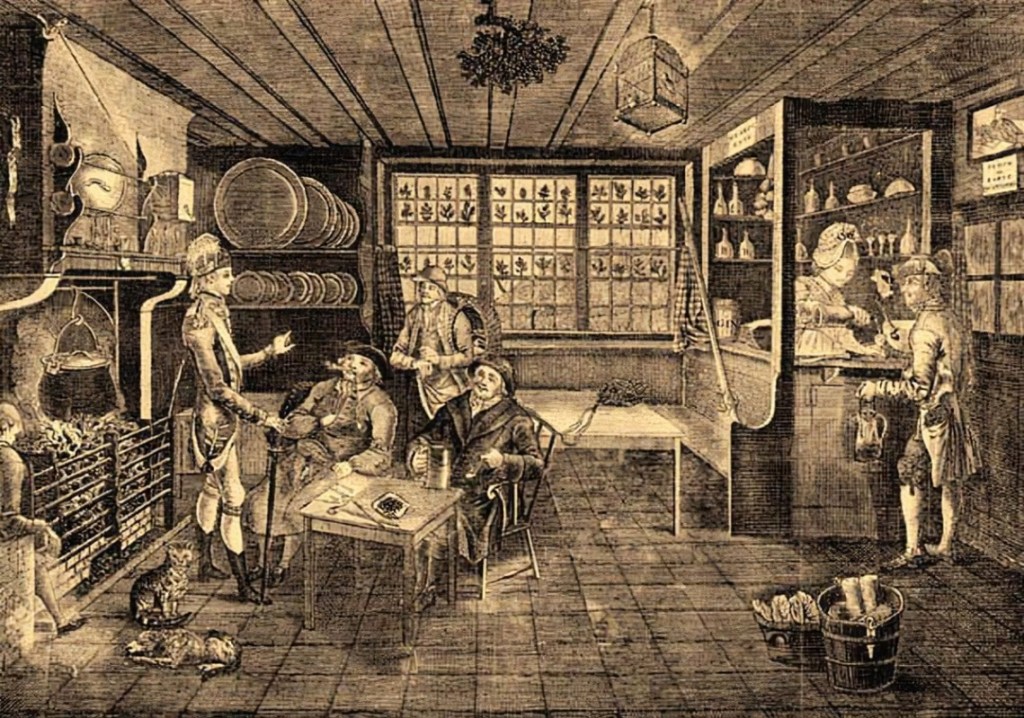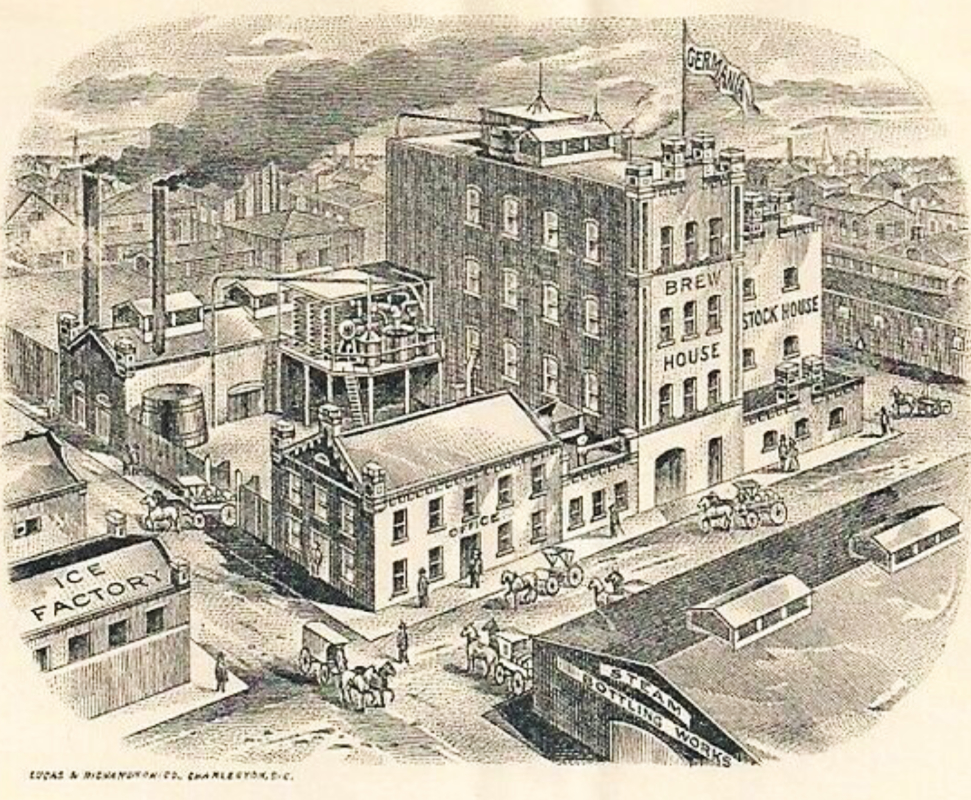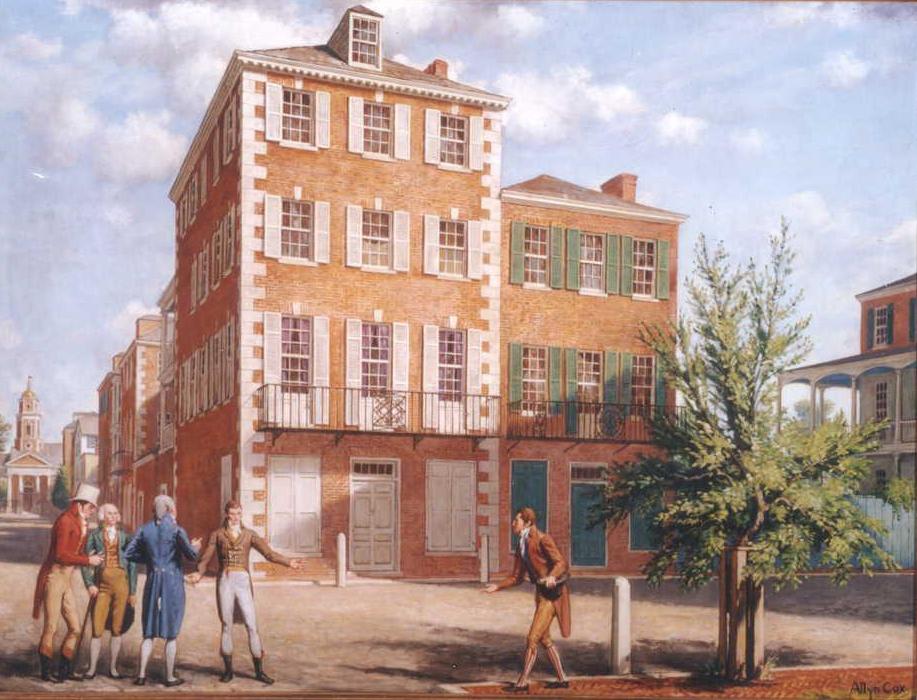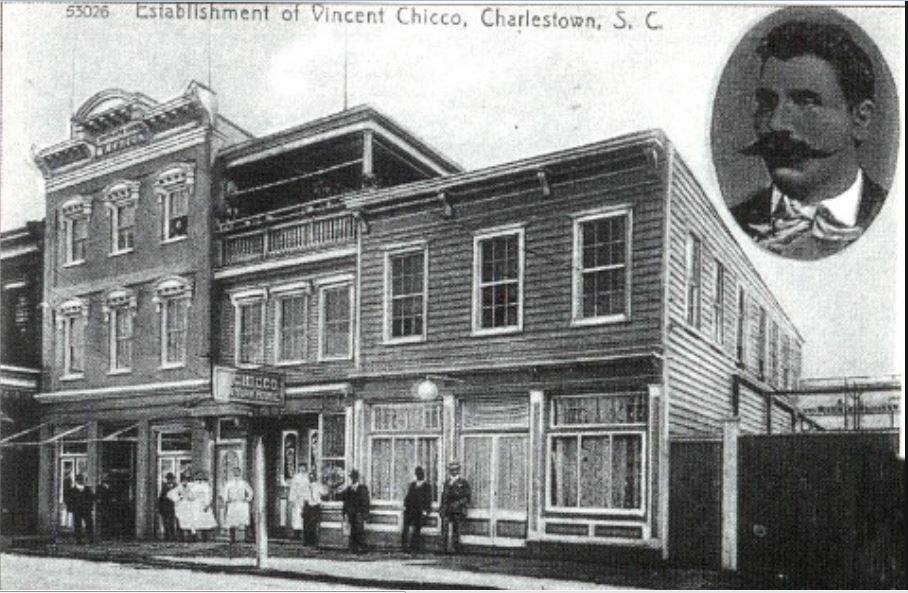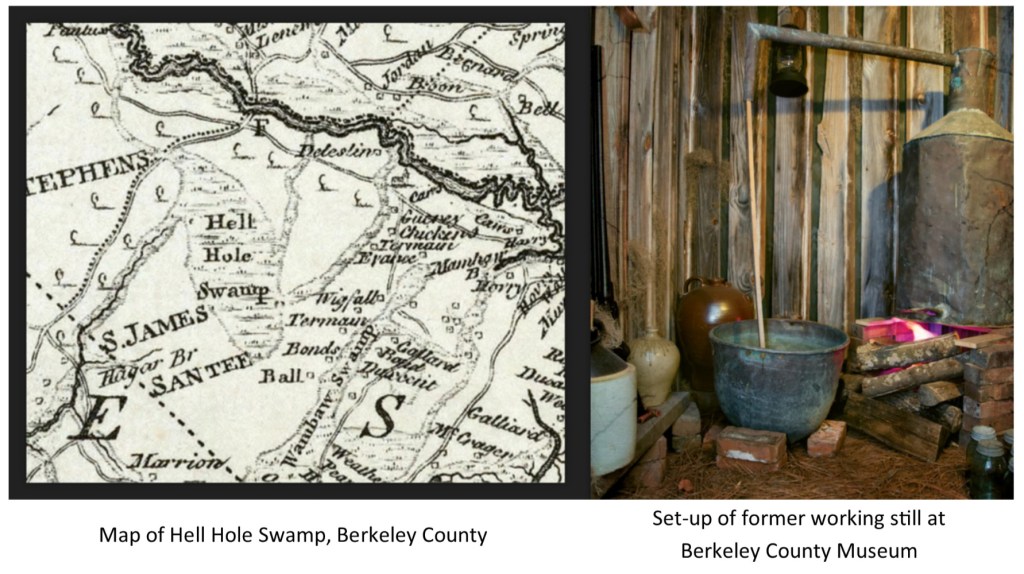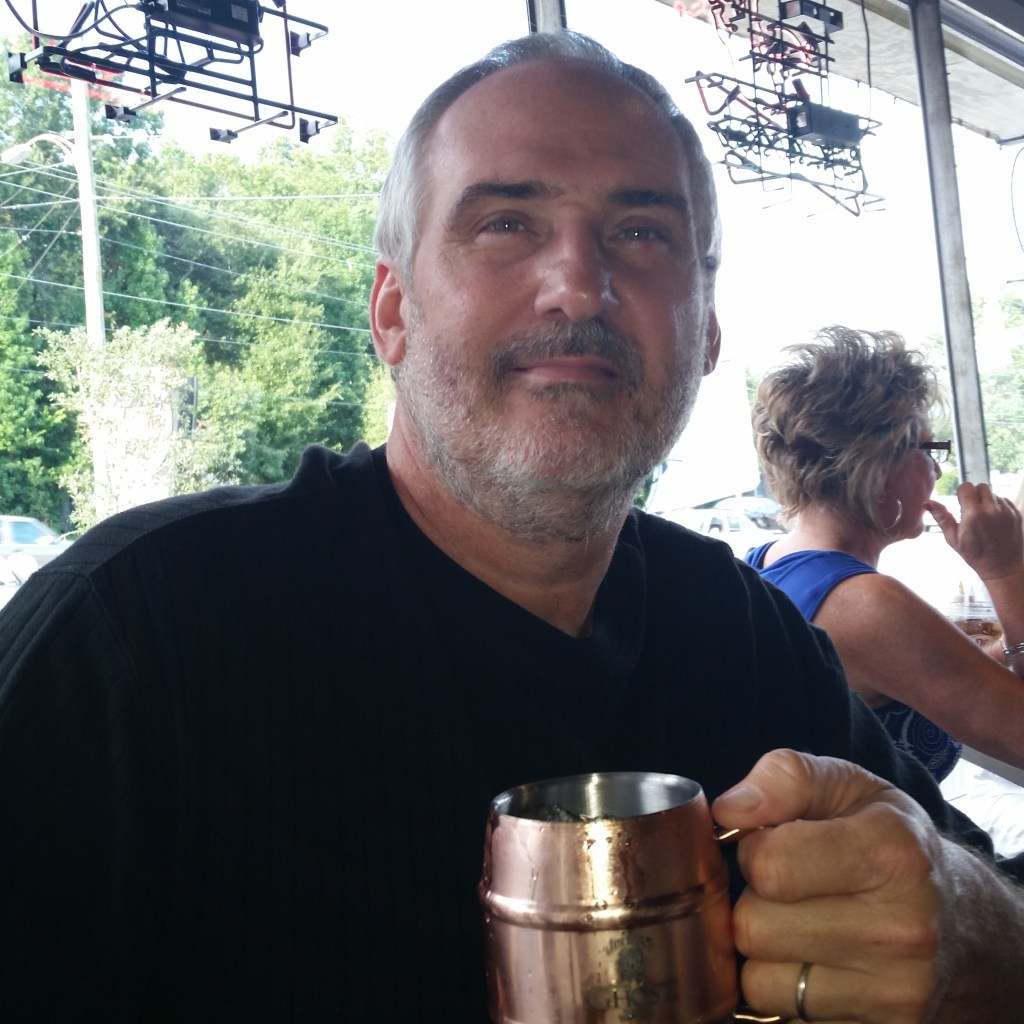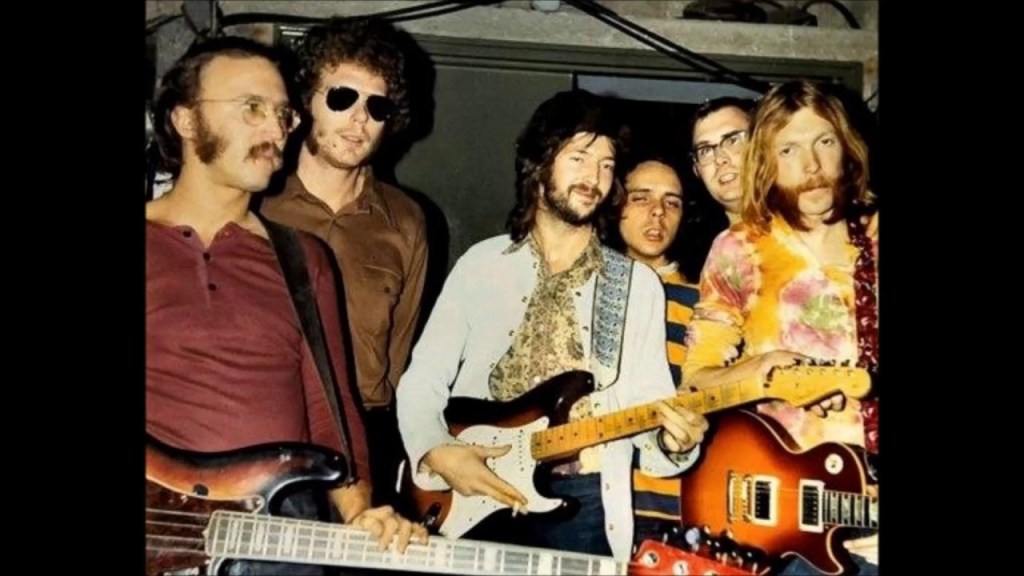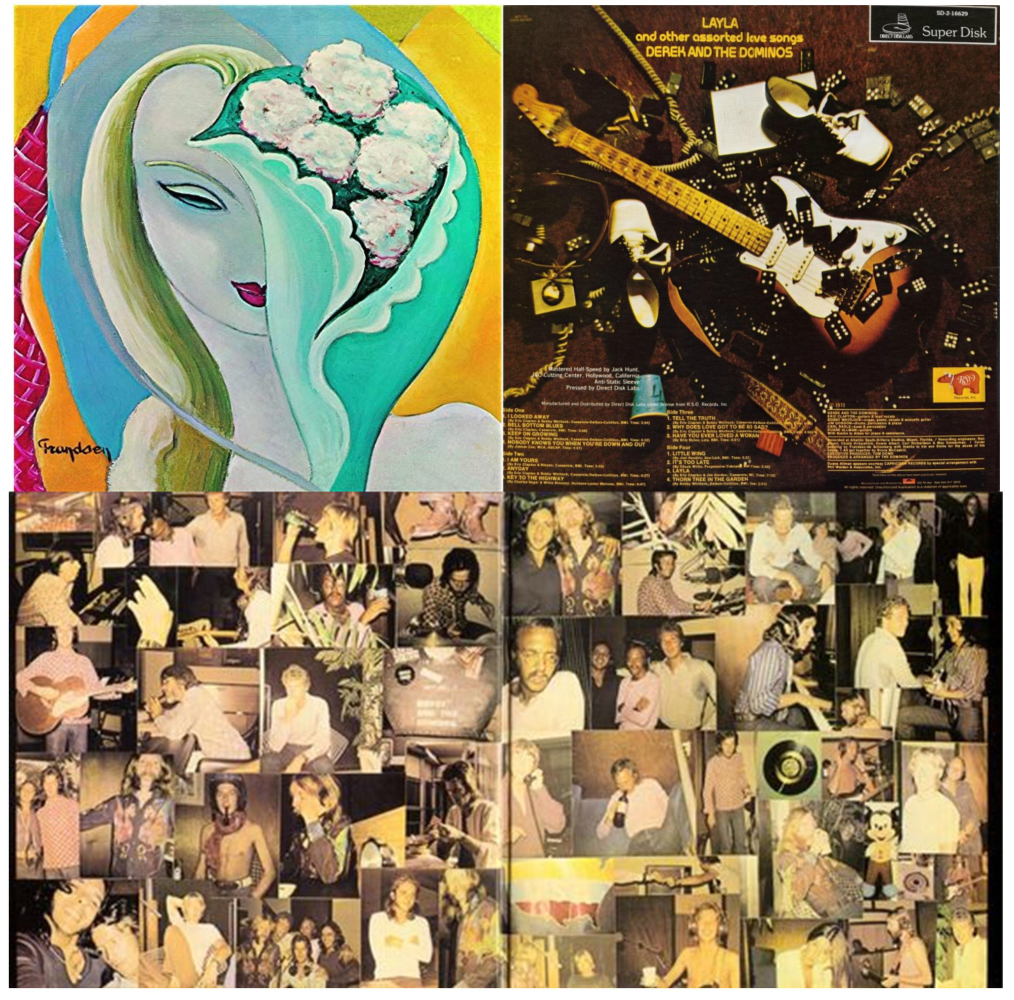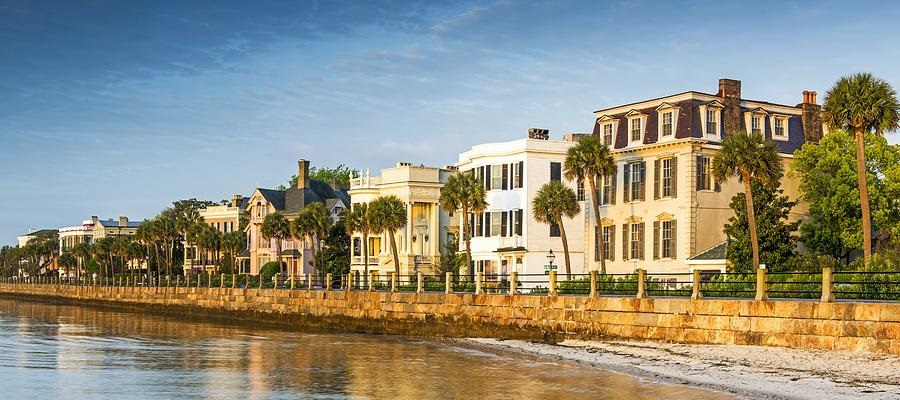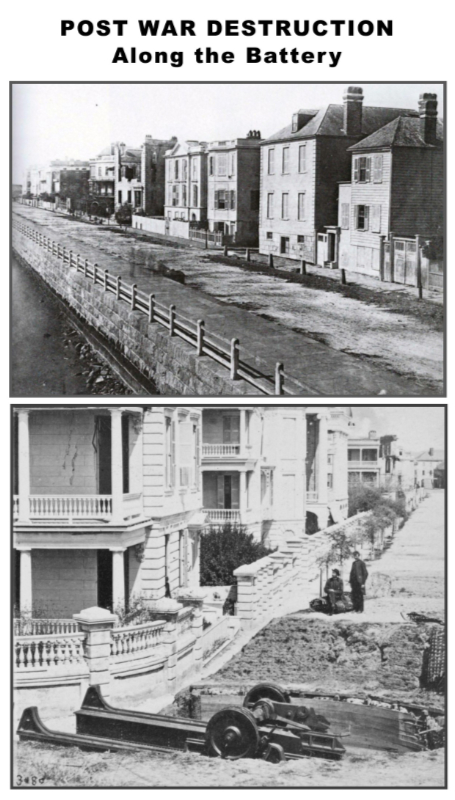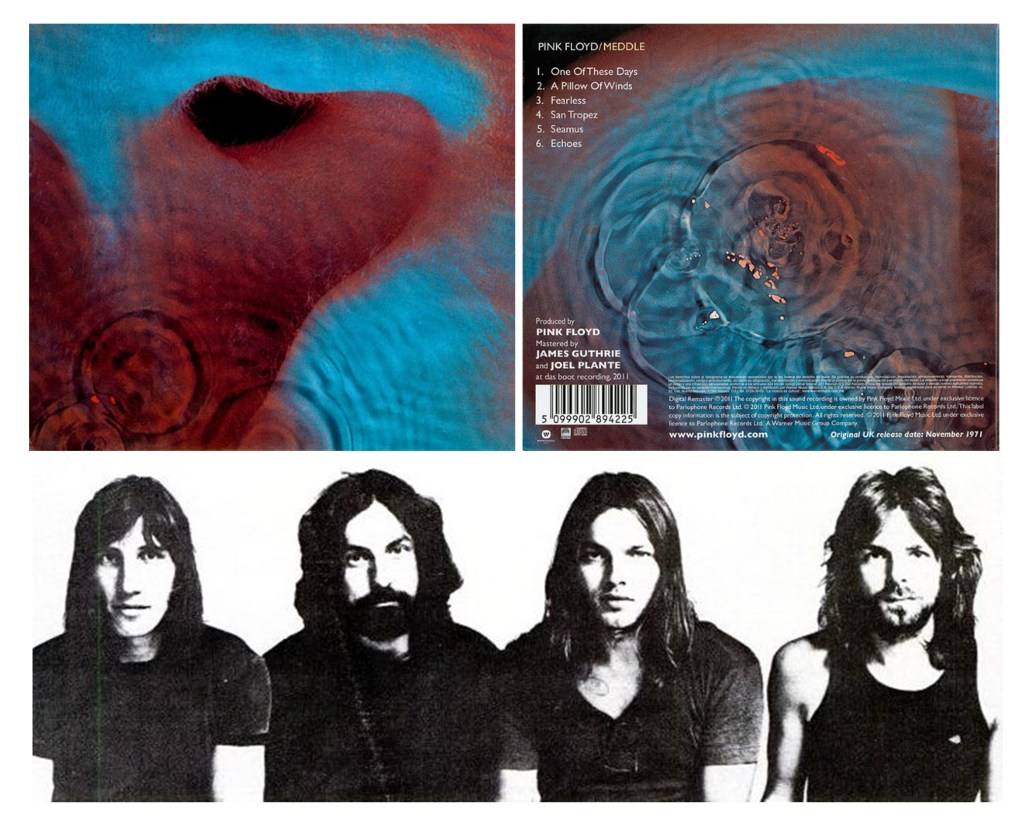In 1830, the average American man consumed 50 gallons of liquor per year. That number does not include beer. In Charleston, the rate was higher. Carl Bridenbaugh of Boston wrote: The importation of liquors at Charleston Town staggers the imagination – 1500 dozen (18,000) bottles [of ale]… 1219 hogshead [wine]…and 58 barrels of rum.” This was a six month supply for one modest tavern.
Gentlemen were encouraged to drink; in fact, part of being a gentleman meant holding your liquor. Having the reputation of being a “three-bottle man” was a mark of excellence. A “three-bottle man” consumed at least three bottles of whiskey or wine per day. Again, that did not include beer, which was consumed in the same manner as modern soft drinks.
It has been observed that during the settling of the American colonies, the Spaniards first build a church, the Dutch build a fort, and the English built a tavern.
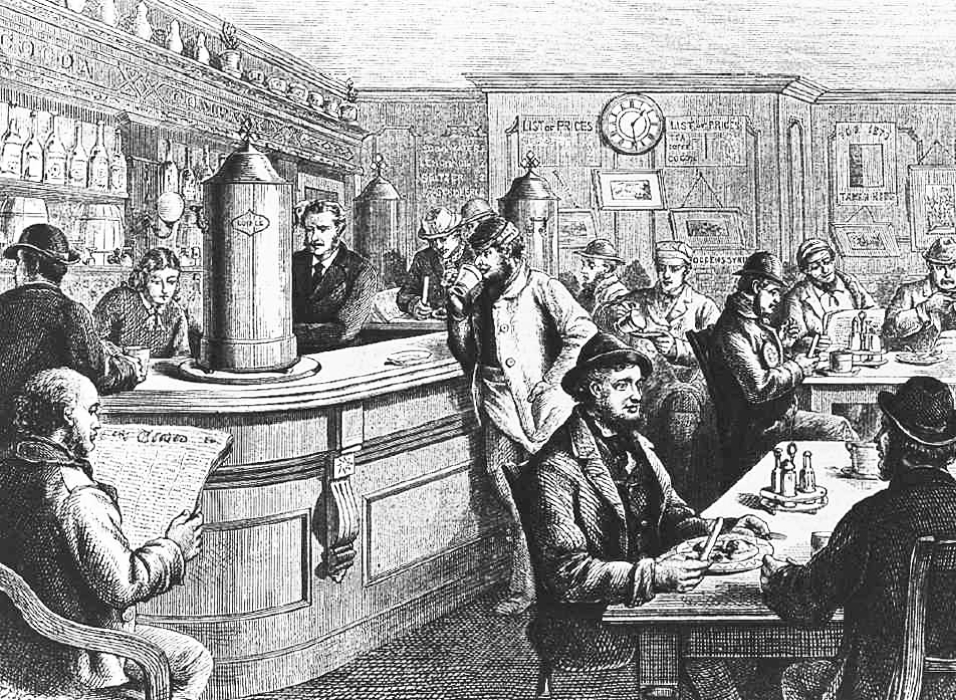
During the first week of April 1670 ninety-three colonists arrived on the Carolina under Captain Joseph West. Some of the provisions on board included 4000 gallons of beer and 30 gallons of brandy. They found the “Water about Town so brackish that it is scarcely potable unless mixed with … liquors.”
Seven months later, Captain West complained that many of the settlers “were so addicted to the Rum, that they will do little whilst the bottle is at their nose.” Ten years later the Council felt it necessary to pass an act for “the Suppression of Idle, Drunken and Swearing Persons” and to “prohibit entrance of punch houses, or tippling houses during time of Divine Service.” The Council finally figured it out – people were going to taverns for worship instead of church. It was the beginning of a long (and mostly unsuccessful) tradition by Charles Town politicians to pass laws to direct people away from the bars and into the churches.
The first Anglican minister, Reverend Atkin Williamson, was dismissed in 1681 for baptizing a bear while drunk. In 1708 a ship set sail from England, bound for Charlestown, carrying the Reverend Gideon Johnston, appointed commissary to the colony. As was customary during a trip from England to Carolina, before making the long passage across the Atlantic, the ship stopped to re-supply at the island of Madeira, off the coast of Portugal. Reverend Johnston went ashore and he sampled a new drink – a golden-colored spirit named after the very island. Madeira wine is aged at least twenty years in casks and then bottled and allowed to mature for another thirty to seventy-five years.
Reverend Johnston enjoyed the wine so much that he missed the departure of his ship. He arranged for a second departure and persuaded the captain to load several cases of Madeira to enjoy during the voyage. Johnston’s second ship arrived in Charles Towne without the reverend on board. He was found marooned on an island off the coast without food and water – apparently abandoned by the ship’s crew.
Margaret Kennett, Charles Town’s first business woman, commented that the locals are “Trained in Luxury and are the Greatest Daubauchers in Nature.” Josiah Quincy of Boston was astounded by the behavior of the citizens. He wrote: “They are devoted to debauchery and probably carry it to a greater length than any other people.”
Charles Town was one of the busiest port cities in the colonies by 1720. There were often more than 150 sailing vessels from Portugal, Spain, England, France, Italy, and the Caribbean at dock in the harbor. With an average of twenty sailors per ship, that would an influx of 3000 men in the city who roamed the streets in search of one thing: entertainment, usually in the guise of wine, women and song.
In 1763, sixty-six tavern licenses were issued. Five years later the number had doubled – approximately one tavern for every five adult males. Half the licenses were issued to women. It was illegal for artisans to operate a drinking establishment, so most dodged the law by having their wives obtain the licenses. Most of the taverns doubled as brothels – alcohol on the first floor, flesh on the upper floors.
Just before the outbreak of the Revolutionary War the Assembly became concerned that the Night Watch could not contain the “growing Vice and Immorality.” The Assembly, however, did little to solve the problem. They merely ordered the loose women to move from the waterfront district to an area four blocks west called Dutch Town, as it was settled mainly by Germans. Within the shadow of the St. John’s Lutheran and Unitarian church steeples, the six-block section of Clifford, West, Beaufain, Logan and Beresford (Fulton) Streets soon became a “constant scene of nightly brawls and riots.”
In 1780, during the British occupation of Charles Town, orders were posted for soldiers to avoid bawdy houses. Several of the Ladies of Eden were shipped out of the city for “health reasons” but most of the houses did a booming business where the soldiers found “willing female companionship.” Soldiers are always good for the bordello business. Lucky for the madams, the men of Charleston started a war against Yankee aggression in 1861.
The governor and his council tried in vain to regulate the sale of liquor. The selling of intoxicants was “observed to be mischievous and to impoverish the otherwise sober planters.” The laws also tried to limit the amount of credit a tavern keeper could extend to customers. Ignoring the liquor laws became a long tradition in the low country.
Taverns were much more than drinking establishments; they were prominent social institutions. Taverns hosted political functions. Men’s clubs and other charitable organizations held their meetings in the building.
Up until the 1760s, most of beer consumed in Charles Town was imported from Philadelphia, Liverpool, or Bristol, Connecticut. There was a real need for a local brewer, but few men in the city had the skills, until Edmund Egan arrived.
Egan was born in England and was an apprentice under a London brew master before his arrival in Charles Town. He encountered trouble setting up business. First, he was a newcomer, with no reputation or references, making it difficult to arrange the financial credit needed to procure brewing equipment. He supported himself for a few years as a fencing master and also went into a factoring partnership with Nathanael Greene and William Coates.
In 1765, when the passage of the British Stamp Act ignited a passionate support of American manufacturing; Egan found a partner with John Calvert. They announced that a Charleston brewery was now in production. They advertised the sale of “Doubled brewed Spruce beer, table and small beer.” They also offered to ship any quantity above five gallons.
Two years later, Parliament passed The Townsend Acts, which forced another round of boycotts against England by the Colonists. Egan had trouble getting quality hops and malt. In 1770, Egan was able to import his own barley seeds and convinced some local planters to lay in a crop, and one year later, Charles Town had their first constant supply of local brew. By 1775, Egan was outselling all import brews in Carolina. According to 1772 financial records Egan’s income was almost 20,000 pounds.
His brew house had two brick vaults 41 feet long by 13 feet. The malt house and kiln were 100 feet long by 22. Egan employed eight Negroes, two coopers who built casks and kegs, and six brewers. He also had two “house wenches” on the property.
During the Revolution, Egan tried to expand his business by building a distillery on Coming Street, which failed and was abandoned. After the war, Egan borrowed money from William Gibbes to establish a new brewery, but he died before the venture could be completed.
During the years preceding the Revolutionary War, Christopher Gadsden and the “Sons of Liberty” met at Shepheard’s Tavern.
Charles Shepheard built his tavern at the corner of Broad and Church Streets in 1720 and it quickly became the most important public house in the city. In 1734, Shepheard’s hosted the first theatrical season in American in the Long Room upstairs. Two years later, on October 28, 1736, the first meeting of the Ancient and Honorable Society of Free and Accepted Masons, took place in the tavern. And later, in 1801, “The Supreme Council of the 33d Degree of the United States of America” was opened in the Long Room. Mrs. Coate’s Tavern (corner of East Bay Street & Exchange Street) exhibited what was considered to be the best collection of wax figures in America – including life-size replicas of George Washington, Dr. Ezra Stiles (late president of Yale College), David and Goliath and others. After Mrs. Coate’s death in 1824, the tavern was closed and replaced with a liquor store in the late 1890s, which is currently still open for business.
One interesting club was called “Club Fourty-Five”. On November 21, 1772, a group of the “Sons of Liberty” met at the Liberty Tree at Mazyk’s pasture to swear their defense against the tyranny of the British. The tree was decorated by 45 lights and 45 skyrockets were fired. Forty-five men paraded down King Street to Broad Street to Dillon’s Tavern. Forty-five lights were placed upon the table, along with forty-five bowls of punch and forty-five bottles of wine, which was then consumed.
In the late 18th century, due to the arrival of French refugees from Santo Domingo, taverns were being challenged in popularity by French coffee houses. However, most people believed coffee did far greater harm to a person than did rum, whisky, brandy and beer. Some taverns even took out newspaper advertisements extolling the virtues of liquor and the ill effects of coffee. The coffee house merchants fought back and published pamphlets of the benefits of the genteel practice of drinking coffee.
Coffee houses may have experienced an ebb and flow of popularity through the decades – enjoying resurgence during the 1960s and the recent phenomenon of Starbucks is impressive – but liquor has ALWAYs been in fashion in Charleston. Even when it was illegal.
Prohibition – Wringing, Sopping Wet!
The Charleston Courier complained that Prohibition ruined Charleston’s tastes for fine liquor. Because they could no longer obtain brandy and Madeira, they guzzled “Hell Hole (Swamp) corn likker”.
The hostility Charleston felt toward Governor Tillman turned to outright hatred when Tillman announced the formation of the State Dispensary Board. One thing Tillman wanted to control was the flow of alcohol in the state. The upstate of South Carolina was more conservative and fundamental than the low country, and they frowned on drinking and gambling. Tillman was a clever enough politician to realize that he could not prohibit alcohol, so he devised a system through which the state could control its distribution, which led to the Dispensary Act.
The Dispensary was a state-wide state-owned liquor monopoly, and was intended to close down forever all saloons and liquor wholesalers, and to restrict the sale of alcoholic beverages to state-operated dispensaries. The Board (the governor, comptroller general and attorney general) appointed county dispensary boards, which chose one dispenser per county seat (Charleston and Columbia could have more). No children or habitual drunkards were allowed to make a purchase. All buyers must register before purchasing liquor. Alcohol could be sold only between the hours of sunrise to sunset. No private citizen could legally manufacture or sell whiskey. The people of Charleston were outraged by the law, not only because they considered it to be “Tillman’s baby”, but because of their 250 year opposition to any regulation of their liquor. Tillman commented about his Dispensary system during a speech in Charleston:
Why do Charlestonians hate me anyhow? Because they are behind the times and because their streetcars are run by mules instead of electricity. They can go to the devil in their own way if they want to. I am going to have the Dispensary down here whether you want it or not.
On July 1, 1893, the State Dispensary Board opened for business. If a community wanted a dispensary they petitioned the county board, which issued a license. The board also authorized Dispensary constables to enforce the law, often with little supervision. The Constables were heavy-handed in their enforcement, searching private homes on the slightest context and spying on their neighbors. In dozens of cases, the constables killed several citizens but were promptly pardoned by Governor Tillman.
In response to those tactics, Charlestonians began to attack constables by ambush, lying in wait for them armed with clubs and whips. Tillman told the state legislature: “Almost all the people of Charleston are in league against the law and determined to overthrow it.” He stated: “The law is going to be enforced. If it results in killing somebody, it will have to be done, that is all.”
Law-abiding citizens took pride in resisting the tyranny of the Dispensary. They had enjoyed rum, beer, wine and whiskey in public bars and restaurants for generations so they simply ignored the Dispensary law. Illegal bars, called “Blind Tigers”, sprang up around the city, and prominent citizens engaged in illicit liquor traffic. Governor Tillman called it “raising hell on Chicco Street”.
The quantity of liquor supplied by the Dispensary was not enough to supply Charleston County drinkers, and since nature abhors a vacuum, soon a bootleg whiskey industry was thriving. Vincent Chicco became the state’s most notorious liquor dealer. Chicco manufactured quality liquor and grew rich and powerful. He served on Charleston City Council for four terms and once even sat on a grand jury investigating liquor violations. In other words, Chicco sat on a grand jury that was investigating himself! Another prominent bootlegger was W. J. Cantwell, brother of the Charleston chief of police. Most of the city leaders opposed the Dispensary, and looked the other way at violations, or often, facilitated the flagrant flaunting of the law.
In April 1894, the South Carolina Supreme Court (by a vote of 2-1) ruled the Dispensary an illegal monopoly. However, Governor Tillman was prepared. A new bill passed the state assembly, and when the two judges who voted against the Dispensary came up for renewal, Tillman replaced them with two of his friends and the new law was declared constitutional on Oct. 8, 1894. The Dispensary was too successful (monetarily) to cease. During its thirteen year existence its profits were $10 million.
The Dispensary quickly came under attack due to corruption among dispensary officials. The Board was subject to bribes from various dealers to buy particular brands of liquor. The distillers were ready to give handsome “gifts”. Local officials were bribed to overlook the blind tigers.
In 1896, in an attempt to clean up the corruption, the Dispensary Board changed its directors from the Governor and other State officials to men elected by the legislature. Soon there were hundreds of people in the state capital schmoozing legislators to become members of the Dispensary Board, bribing for the right to get their hands on the “liquor money”.
Also in 1896, due to flagrant and successive dispensary violations, Tillman’s successor, Governor John Evans, placed Charleston under state police control. Evans appointed his own police commissioners and for over a year Charleston law enforcement was under state control. The result was an improvement in the enforcement of liquor laws, but a growing dissatisfaction among most of the locals who were affected by that enforcement. Twenty-three Protestant ministers issued a statement endorsing the improvement in law enforcement, but the letter was not published by the News and Courier, which opposed the state constable rule. For some the Dispensary was seen as a complete and massive failure. Its intention had been to institute a quasi-prohibition, but it had only succeeded in increasing alcohol consumption. In 1898, the prohibitionists (the Drys) made a strong run for the governorship but failed.
The Dispensary was repealed by the legislature, and thereafter, each county was free to continue its own dispensary system or adopt total prohibition. Under the new system, each county could have as many Dispensary licenses as they wanted. In 1906, the state of South Carolina granted 297 liquor licenses. Two hundred and thirteen of them were issued in Charleston, fifteen bars were located around City Hall and nineteen operated within a block of St. Philip’s Church.
Gov. Coleman Blease(1910-14) had the backing of the whiskey and gambling interests. He strongly resisted the1912 law that prohibited horse racing. Charleston, of course, ignored the horse racing ban. In fact, the manager of the Charleston race track was quoted in the Cincinnati Enquirer that racing would continue since Charleston had a long history of ignoring laws it did not like. During his second inaugural Governor Blease defended his actions: “They are yelling, ‘What is the Governor going to do about the Charleston races?’ Do they expect me to dress up like a preacher and beg them not to race?” He continued to ignore Charleston’s violations of racing and drinking. Blease said that “if a man wanted to sin, that was his own business, not the state’s.”
Blease was another in the long line of corrupt South Carolina Governors who flaunted their power. During his term Blease freed more than 1500 convicts, many who were guilty of murder (of blacks) and arson. He also believed in white supremacy. He denounced members of the state legislature as being born in North Carolina and having Yankee parentage. He encouraged lynchings, and opposed education for blacks at white taxpayer’s expense. He stated, “I have no fear of Negro contacts, neither for me nor any of my family – for each of them, I am proud to say, is physically able to pull a trigger whenever it should become necessary.”
He called newspaper reporters “a dirty set of liars” and praised Lt. Governor Jim Tillman’s murder of N.G. Gonzales, editor of The State newspaper. Gonzales had been a long opponent of Tillman and Blease and their policies. In his newspaper Gonzales had exposed Tillman as a “proven liar, defaulter, gambler and drunkard.” On January 15, 1903, Tillman had walked from the Senate chamber and shot the unarmed Gonzales on the street. Tillman was acquitted of murder by claiming self-defense.
Mayor Grace testified in 1913 that Charleston had 250 Blind Tigers for a population of about 60,000. He bragged that he had instituted a system where the city fined each liquor operator and bordello $50 every three months. Grace claimed that it was a fair system. “”If I wanted, I could fine them every time they sell a drink,” he said. He made no effort to close them down. The fines provided thousands of dollars. In fact, without the liquor and prostitution fines, the city budget would have been in the red. The mayor rarely ordered raids on Blind Tigers, and then it was “just for show”. He claimed that “Blind Tigers are too much of the web of life to close them down.”
In 1915, the Drys won a state-wide referendum, ending all legal sale of alcohol within the state, four years before national prohibition took effect. However, the referendum did not repeal the “Gallon-a-Month” law, which permitted the importation into the state one gallon per person per month. Men like Vincent Chicco, W. J. Cantrell, Leon Dunlap and Frank “Rumpty Rattles” Hogan were more than happy to fill the void of legal liquor with their bootleg product. By the time national prohibition was in effect, Chicco and other bootleggers had their distilling and distribution systems in the Hellhole Swamp area of Berkeley County organized and operating as smoothly as a Ford assembly line. During Prohibition more than 20,000 South Carolinians made a living as a bootlegger, moonshiner or rumrunner.
Hell Hole Swamp in Berkeley County, north of Charleston, produced so much corn liquor that it gained a national reputation. Governor John G. Richards, a rabid Prohibitionist, claimed that, “Berkeley County is a festering sore in South Carolina.” Charleston newsman Tom Waring Jr. wrote, “Hell Hole Swamp, exuding an aroma of spirituous liquors which reeked throughout the Southeast, was a stench in his nostrils.” Richards, already unpopular in Charleston, became openly hated when he resurrected a blue law that made selling gasoline and playing golf illegal on Sundays.
Mason jars filled with Hell Hole Swamp moonshine were shipped by the boxcar-full to Al Capone’s Chicago, lined the shelves of speakeasies in New York, and filled the teacups at the blind tigers in Columbia, Savannah, and Atlanta. Meanwhile, in high society Charleston, Hellhole Swamp supplied the booze for the afternoon cocktails to which they were long accustomed. One eldery society lady declared, “Of course we continued to drink during Prohibition. I don’t know where Daddy bought the liquor. It was just delivered to the back porch every morning with the milk.”
On April 7, 1933 Congress repealed national prohibition and on the following day Charleston merchants were offering 3.2% beer for sale, which violated state law, but no one complained. Mayor Maybank, once called a “drunken sot”, announced that it did not “matter whether or not the state legalized the sale of alcohol, since tourists wanted it, and Charleston wanted tourists and we will give liquor to them legal or not.” Maybank was later elected Governor of South Carolina.
South Carolina legalized the sale of beer and wine, but kept in place the prohibition of distilled alcohol. Restaurants and bars could be licensed to serve wine and beer during the week, until midnight on Saturday and never on Sunday. Since distilled liquor was against state law there were no legal hours to serve whiskey, hence there was no license to lose by selling it. Distilled liquor was available in Charleston around the clock, seven days a week, much to the dismay of the State Law Enforcement Division (SLED).
In his book The Charleston Gospel, J. Francis Brenner describes the system the city developed for keeping the liquor flowing. Whenever SLED officials came to town to investigate the serving of distilled liquor they would pay a courtesy call at the Charleston police station, informing the local officers that state constables were in town. Chief of Police Herman Berkman would direct the SLED officers to a couple of small time “half-pint” dealers working out of their cars. Meanwhile, phone calls would be made from the police department. Two bars would be notified that SLED was in town. In turn, those two bars would call two more bars. Those four bars would contact sixteen bars and within half an hour, the city would be as dry as a Puritan in the Sahara. The whiskey disappeared and when SLED walked through the door, only beer and wine could be found on the premises.
Whenever the city needed alcohol for a social function they would instruct Chief Berkman to knock off a few half-pint dealers or request “donations” from some of the better restaurants and clubs. It was also well known that local law enforcement officers would “convoy” moonshiners’ cars down Highway 42 from Hellhole Swamp. For allowing the safe passage of liquor into the Holy City the officers were paid in pint bottles and cold hard cash, some of which worked its way up the chain of command. It was a smooth and profitable operation for many years until 1951. That was when patrolman James Chassereau became an informant for the United State government. Federal agents hid in the trunk of Chassereau’s police cruiser and recorded conversations between police and bootleggers. Nine policemen and one city councilman, including former chief of police Julian Williams, were arrested and sent to federal prison for violating federal liquor laws.
During the trial the prosecutor asked Chassereau if, while serving on the county police, he did anything other than “fool with liquor”. Chassereau answered, “We made a few traffic cases, and answered burglary calls, but our main business was to catch whiskey cars and get what we could out of them.”
Former chief of police Williams was defended by Ernest “Fritz” Hollings. Hollings was soon to be elected governor of South Carolina and in 2004 he retired after thirty plus years as a U.S. Senator. In his defense of Williams Hollings stated that “the government conspired with perjurers and blackmailers to present a gory picture of this community and of the defendants.”
Williams pleaded “not guilty” to all charges. One of the charges was that he was the owner of a property that dispensed illegal whiskey from a freezer in the back of the building and from the Kelly’s Newsstand next door. Kelly’s was so well known as a place to buy after hours liquor that you could call a taxi company and ask them to pick up whiskey and deliver it to your house. Williams claimed to know nothing about the liquor being handed out on his property. The Reverend John J. McCarthy of Blessed Sacrament Roman Catholic Church testified as a character witness for Williams. Father McCarthy stated, “I know that Julian would not commit a sin of perjury.”
Charleston has always been a city that loved its alcohol. From the earliest settlers who arrived with twelve tons of beer, to the Reverend Gideon Johnston who missed his ship because he was drunk on Madeira wine, to the little old blueblood ladies sipping liquor on their piazzas from fine China tea cups, Charleston has always been a drinking town with a historical problem.
Note: The previous material was exerpted from my two books, WICKED CHARLESTON: THE DARK SIDE OF THE HOLY CITY, and WICKED CHARLESTON, VOL II: PROSTITUTES, POLITICS & PROHIBITION.
Cheers!


